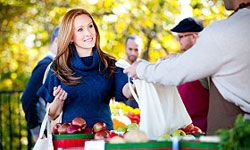You've probably heard the phrase "buy local" countless times and may have even seen the slogan emblazoned on store windows, but have you ever thought about what it actually means? You're buying local anytime you purchase something from an independent business, artisan or farm. Buying local can often save you money because there are fewer hands involved. For example, you'll likely save money by purchasing green beans from the produce stand on the corner because the farmer doesn't have to divvy up his profits between the packer, the transporter and corporate and store employees the way chain supermarkets do.
Buying local can also provide an economic boost your community. In fact, the New Economics Foundation found that when people buy local, twice the amount of money stays in the community compared to areas where people bought more imported and out-of-state goods. So, while you're getting a great deal on something, you're also doing good things for your community, and that's definitely a deal you shouldn't pass up!
Advertisement
Read the next page to find out what type of chain stores often offer local products.


